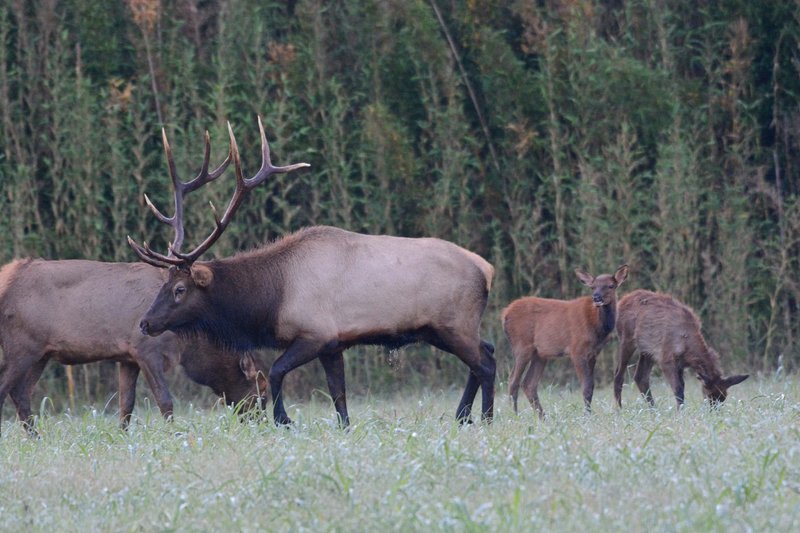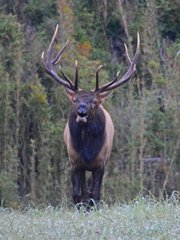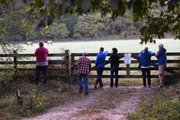A rack of pointed antlers rose high above the bull elk parading its majesty in a golden meadow near the Buffalo National River.
Binoculars and zoom lenses cradled in the hands of wildlife watchers gave a close-up view of the bull and a dozen cow elk. The herd munched grass, pranced in the heavy dew and dazzled a small group gathered to see them.
Gazing at these Rocky Mountain elk is worth the drive. Elk watchers on this autumn day got more than they bargained for. The big bull raised its head and let out an eerie bugling call for all to hear. The elk's high-pitched squeal covered two octaves, sending low notes, then high, bouncing through the river valley.
An elk's bugle can tingle the spines of visitors to the Buffalo in late September and October. It's elk mating season, and the best time to watch elk put on a show near the river.
Bulls bugle in dawn's gray light. They fight, stomp heavy hoofs and bugle for the prize of being boss bull and to attract females.
The show brought Terry Stanfill of the Decatur area to the Buffalo at the crack of dawn on Sept. 29. His camera and powerful zoom lens were by his side as the photo safari began.
Elk can be seen in the fields between Boxley and Ponca at dawn and dusk. A drive along Arkansas 21 and Arkansas 43 in Boxley Valley puts travelers in elk country. That short window between first light and sunrise is magic hour for elk watching.
Stanfill hadn't been in Boxley Valley two minutes before he spotted six elk grazing far away at the edge of a forest. Pull-off areas have been built along the highways so visitors can stop their cars to get out and have a look.
Stanfill burned some megapixels and got some decent photos. But where were all the other elk watchers usually on patrol in the valley?
A drive east toward Ponca gave the answer. Twenty or so bulls and cows grazed in a field near the low-water bridge river access. Six or so people pressed up against a wooden gate clicking away with cameras or marveling at elk with binoculars.
Excitement hit fever pitch when half of the elk wandered into the forest less than 30 yards away. A spike bull crossed the gravel road and sauntered toward the river. Larger bulls bugled.
Stanfill's camera filled with so many stunning photos he stopped shooting to bask in the show. Sometimes the camera of the mind captures the best memories.
October elk watching is an early-morning adventure. Stanfill arrived at first light. The photo safari was over by 8:30 a.m. Sunshine prompts elk to retreat into the forest where they spend the day lounging and eating lush fall greenery.
There's a hunting season for elk in Arkansas during October. Boxley Valley isn't in the zone where hunting is permitted.
This "tourist herd," as some call the Boxley Valley elk, numbers about 150 to 200 animals, said Brad Savage with the Arkansas Game and Fish Commission's Ponca Elk Education Center, on the main drag in Ponca.
Arkansas has about 600 elk total, he said. Forty years ago there were none.
Elk were hunted to extinction in the state during settlement times. These were eastern elk, as opposed to Rocky Mountain elk. An effort to re-establish elk in Arkansas took place in the 1980s and was successful.
About 14,000 to 16,000 visitors stop by the Ponca Elk Education Center each year, Savage said. A fair number watch elk in the field early, then come to the center when it opens at 10 a.m. Tuesdays through Saturdays.
"Bugling starts in mid-September and goes the full month of October," Savage said.
There's no guarantee elk will be seen, but the chances are good to experience the head-butting, foot stomping, bull snorting and bugling show that elk put on at the Buffalo River each fall.
Create elk memories
Nature photographer Terry Stanfill offered tips for watching and photographing elk along the Buffalo River.
• Get there early. The best viewing and best light for photography is from first light to sunrise. Elk may also be seen at sunset.
• Use a tripod. Elk photography at first light requires slower shutter speeds. A tripod steadies the camera for better photos.
• Filling the entire viewfinder with an elk makes good pictures, but including some of the environment around the elk, such as a meadow or forest, makes nice shots, too.
• Keep a distance. Elk are wild animals that may spook and charge if a person gets too close.
• Spend time simply watching the animals.
Source: Staff report
Flip Putthoff can be reached at [email protected] or on Twitter @NWAFlip
Sports on 10/10/2017



